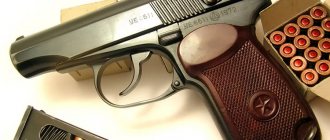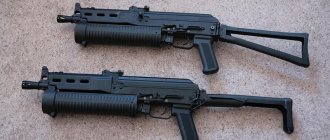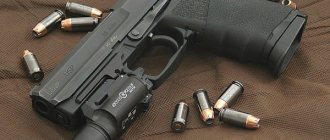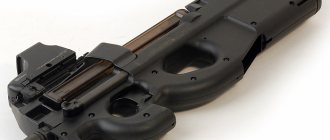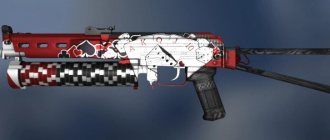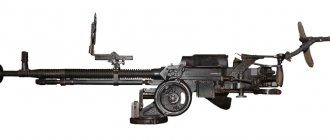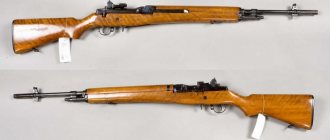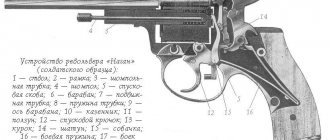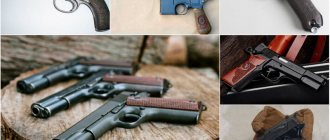Basic technical data
Basic technical data are given in Table 1.
Table 1
| Parameter name | Meaning |
| Caliber, mm | 9 |
| Weight of pistol with magazine without cartridges, kg | no more than 0.45 |
| Magazine capacity, pcs. | 14 |
| Overall dimensions of the gun, mm, no more | |
| length | 151 |
| width | 31 |
| height | 116 |
| Initial bullet speed, m/s | 270± 15 |
| Assigned resource, lines, no less | 4000 |
Composition of the pistol
The list of assembly units and parts of the pistol in accordance with Figure 2 is given in Table 2.
| Designation in Fig. 2 | Name | Quantity |
| 1 | Gate | 1 |
| 2 | Extractor spring | 1 |
| 3 | Extractor | 1 |
| 4 | Latch | 1 |
| 5 | Latch spring | 1 |
| 6 | Axis | 1 |
| 7 | Stub | 1 |
| 8 | Return mechanism | 1 |
| 9 | Trunk | 1 |
| 10 | Drummer | 1 |
| 11 | Feeder | 1 |
| 12 | Store body | 1 |
| 13 | Lid | 1 |
| 14 | Spring | 1 |
| 15 | Retainer spring | 1 |
| 16 | Automatic fuse | 1 |
| 17 | Axis | 1 |
| 18 | Trigger | 1 |
| 19 | sear | 1 |
| 20 | Disconnector | 1 |
| 21 | Reflector | 1 |
| 22 | Slide spring | 1 |
| 23 | Axis | 1 |
| 24 | Lever | 1 |
| 25 | Axis | 1 |
| 26 | Shutter lag | 1 |
| 27 | Spring | 1 |
| 28 | The axis whispered | 1 |
| 29 | Magazine release | 1 |
Rice. 2. Assembly units and parts of the gun
AN-S9P8-96 - 9-port 100 Mbps switch with PoE+ up to 96W
The product has been withdrawn from sale. Recommended replacement: AN-S10P8-120
9-port 10/100 Mbps desktop switch with PoE+ up to 96W.
Peculiarities:
- 8 10/100 Mbps ports supporting PoE+ (IEEE 802.3 at/af), auto-negotiation and auto-MDI/MDIX (RJ45 connectors)
- 1 port 10/100 Mbps with auto-negotiation and auto-MDI/MDIX (RJ45 connectors)
Power over Ethernet (PoE):
- 8 PoE+ ports allow you to transfer power and data over a single cable
- Supports up to 30W power consumption per PoE port
- Power redistribution between ports depending on load consumption
- Total power consumption 96 W for all PoE ports
- Support for PoE devices based on IEEE 802.3 at/af standards
Communications:
- CCTV mode allows you to transmit data without power via PoE over a distance of up to 250 meters at speeds of up to 10 Mbit/s
- 8 10/100 Mbps Ethernet ports provide data transmission to TCP/IP networks from IP video cameras, recording devices (NVR / HVR / DVR) and storage devices (NAS), wireless (Wi-Fi / WiMAX) and other devices
- 1 10/100 Mbps port allows you to connect a switch to expand the network, or connect recorders and other TCP/IP network devices
Switching:
- Hardware VLAN support using the port isolation method provides data access control, protection from network storms, and helps prevent virus attacks.
- IEEE 802.3x Flow control support for full duplex mode prevents buffer data loss and improves overall network performance
- Switching capacity 2Gbps
- 1024 entries in the MAC address table with the ability to automatically remember and automatically clear entries in the table by time
- Switching method - storage and transmission (Store and Forward)
- Auto-MDI/MDIX support automatically detects the type of connected cable (straight/crossed) and eliminates errors of incorrect selection of connecting cables between equipment
- The auto-negotiation function on each port determines the connection speed of the network device (10 or 100 Mbps) and configures compatibility and optimal operating mode.
Properties:
- Protection of interfaces from overvoltage, short circuit and reverse polarity
- LED indicators for monitoring device power, informing about the presence of a network connection, its activity and speed
- Metal case and brackets for fixing on a table or wall.
- Plug and Play technology greatly simplifies installation - no special installation or configuration required
- Powered by AC 110-240V via DC48V/2.8A adapter (included).
Delivery set: switch, power adapter, instructions, 4 rubber pads with an adhesive layer.
General information about the design and principle of operation of the pistol
The pistol is an automatic weapon with a recoil-type automatic weapon with a short barrel stroke, in which the supply of a cartridge from the magazine, the chambering of the cartridge in the barrel, the firing of a shot, the removal of the spent cartridge case from the chamber and its reflection are carried out automatically.
The operation of the automation is based on the principle of using the recoil energy of a semi-free shutter.
The pistol is powered by cartridges from a 14-round magazine.
Loading the cartridge into the chamber of the barrel is direct from the magazine.
The shot is fired by pressing the trigger.
The igniter primer is broken by a spring-loaded striker.
The bullet is ejected from the barrel by the pressure of the powder gases.
Under the influence of powder gases, the bolt and barrel, interlocked with each other using a locking device, roll back to the bottom of the cartridge case.
The backward movement of the barrel is accompanied by its rotation around the longitudinal axis. After turning the barrel at an angle of 30°, it is disengaged from the bolt.
The bolt continues the rearward movement necessary to reload the pistol.
During the recoil process, the cartridge case is held by the extractor, and then a spring-loaded firing pin is thrown up and out through the bolt window.
The bolt returns forward under the action of the return mechanism.
When all the cartridges from the magazine are used up, the bolt goes into the slide stop and remains in the rear position.
Safe handling of the pistol is ensured by an automatic safety lock.
Nervous police
Pistols and revolvers USSR/Russia
Initially (the first half of the 90s), the armament of security forces was an outright mishmash: in the gun shops of private security companies, pump-action Remingtons and Mossbergs coexisted with semi-automatic Saigas of .410 caliber (they were of no use for the low power it was not enough, but “it looked like a Kalashnikov”), and the rented Makarovs were equipped with large-caliber hunting rifles, and even with high-quality “optics”. This entire arsenal was often much more powerful than the regular police weapons, which made the Ministry of Internal Affairs quite nervous.
A typical weapon for a 90s security guard: a pump-action Remington 870 with a pistol grip (photo: pers56)
By the beginning of the 2000s, the “supervisory authorities” firmly clamped down on the rights of security guards: only certified 12-gauge weapons of domestic production were allowed to remain from smooth-bore weapons, and long-barreled rifled weapons were generally banned.
The rental of police Makarov pistols (PM) was also closed, and the “service” cartridge 9x17 mm Kurz (aka .380 ACP) and “barrels” for it appeared on the market. In addition, the number of weapons in private security companies was gradually reduced: at first it was allowed to have pistols or revolvers at the rate of one for two, later - one for three.
Operation of pistol parts and mechanisms
Position of pistol parts and mechanisms before loading
The position of the pistol parts and mechanisms before loading is shown in Figure 3.
Magazine 10 is inserted into the base of handle 14 and held there by lock 11.
Rice. 3. Position of parts and mechanisms of the pistol before loading:
1 - trunk; 2 - extractor; 3 - drummer; 4 - shutter; 5 — mainspring; 6 - sear; 7 — feeder; 8 — shutter stop; 9 — magazine spring;
10 - store; 11 — clamp; 12 - automatic fuse; 13 — trigger; 14 — handle; 15 — return spring;
L - breech cut; B - calyx; B - protrusion
Feeder 7 is located at the top and rests against the ridge of the bolt 4. The feeder tooth presses on the bolt stop 8.
The bolt 4 with the barrel 1 under the action of the return spring 15 is in the extreme forward position. The bolt cup rests against the breech section A of the barrel. The barrel is locked.
Extractor 2 is extended into the area where the cartridge is located.
The automatic fuse 12 is in the off position, while the protrusion B of the fuse is in the groove of the handle 14.
The trigger 13 is in the rearmost position.
The sear 6 is lowered and is located at an angle in the disconnector groove.
The firing pin 3, under the action of the mainspring 5, is in the extreme forward position, while the firing pin protrudes beyond the shutter mirror 4.
Position of pistol parts and mechanisms before shooting
To bring the pistol to combat readiness:
— install a magazine 10 loaded with cartridges into the base of the handle 14;
— cock the bolt 4, moving it to the rearmost position and sharply releasing it.
When the pistol is ready to fire, the top cartridge from magazine 10 is in the chamber of barrel 1.
Extractor 2 jumped into the annular groove of the sleeve.
The cartridge next to the upper cartridge, under the action of the magazine spring 9, takes the position of the first cartridge.
The feeder 7, being located at the bottom of the magazine 10, is not able to act on the bolt stop 8.
The trigger 13, under the action of the mainspring 5, is in the extreme forward position.
Automatic fuse 12 is in the “Safety” position, while the protrusion B of the fuse rests against the wall of the handle 14.
The sear 6 is raised up by the end of the bolt delay spring 8 and blocked from being turned off by the horizontal disconnector platform. The disconnector is connected to the bevel of the sear and is located with its upper part in the cutout of the shutter body.
Drummer 3, when cocked, whispered 6. In this case, its rear part, through the hole in the handle, protrudes 1 mm beyond the overall dimensions of the pistol.
The remaining parts of the pistol occupy the position described in subsection 5.1.
Interaction of pistol parts and mechanisms when firing
When you press the trigger, the automatic fuse, pumping, comes out of the stop position. Having gained freedom of movement, the trigger and the sear move backward. The hammer pulls the sear behind it and cocks the mainspring. On the way, the sear interacts obliquely with the disconnector and decreases. In the process of lowering the sear, the striker is disconnected from the sear. The drummer breaks away from the sear and, under the action of the mainspring, pierces the igniter primer. A shot occurs.
From the pressure of the powder gases on the bottom of the cartridge case after the shot, the bolt together with the barrel, on which the bolt acts through the locking surface, move back.
After the moving parts move away by 2 mm, the barrel begins to interact with the fixed embedded part of the handle using screw guides. It rotates 30°, releases the bolt and rests against the protrusion of the embedded part.
The barrel stops after moving 8 mm, and the bolt continues the movement necessary for reloading.
The shutter with its protrusion moves the disconnector to the left, disengaging it from the sear. The released sear rises upward under the action of a spring.
When the bolt moves backward, the sleeve held by the extractor in the bolt cup is squeezed out by the firing pin through the window at the base of the bolt by the force of the compressed mainspring. The striker, which is shifted back, acts on the sear and lowers it. When the bolt rolls back, the return and mainsprings are compressed. The feeder delivers the next cartridge to the dispensing line. The bolt, having reached the rearmost position, returns to the forward position under the action of the return spring. When moving forward, the bolt pushes the next cartridge out of the magazine with its sending protrusion and sends it into the chamber. In this case, the extractor hook slides into the annular groove of the sleeve. The striker engages the sear and moves it forward along with the trigger. The disconnector falls into the groove on the bolt, moving to the right.
The pistol is ready for the next shot.
Interaction of parts and mechanisms of a pistol when cartridges are used up from the magazine
After all the cartridges from the magazine have been used up, the magazine feeder, with its front left corner, lifts the front end of the bolt stop up.
The bolt, resting against the protrusion of the bolt stop, stops in the rear position.
The drummer whispered in a combat platoon.
The magazine spring has the least compression.
The bolt remains in the rear position even after removing the magazine from the pistol grip, holding it on the bolt stop.
The bolt is released from the slide stop (with the magazine removed or inserted) by pushing the slide stop down with your thumb.
Police option
An improved version of the pistol, but chambered for 9x18 mm, appeared around 1999.
Changes in the design were minimal and affected mainly the provision of reliable operation of the automation with the new cartridge. The magazine with a double-row exit of cartridges now holds 14 rounds of ammunition. Over time, the magazine acquired a lid with an additional platform for holding the little finger. The P-96M pistol reached a record 375 g of weight without a magazine for military weapons and became lighter than many less powerful low-loading subcompacts. Pistol P-96M. Photo by the author
The remaining design features remained unchanged for the entire Ef family. The sights had additional marks made of white paint to allow aiming in low light conditions. The double-sided push-button magazine latch allowed the pistol to be adjusted for left-handed use with simple manipulations. The firing pin, protruding a few millimeters, additionally indicated the presence of a cartridge in the chamber. In this case, the spring-loaded firing pin also acts as a cartridge reflector, having a special protrusion for this purpose.
In 2000, Tula marketers planned a large-scale “offensive” on the police classic - the PM pistol. The announced plans included replacing the standard Russian police pistol with a new Tula one and launching mass production at the Tula Arms Plant. Looking ahead, let's say that neither one nor the other happened, but to begin with, the production of P-96S pistols was transferred to the facilities of the Tula TsKIB SOO, where the production of P-96M also began. Soon the pistol was adopted by the Federal Bailiff Service, the Prosecutor's Office and the Ministry of Internal Affairs of Russia.
In addition to the ultra-light pistol, an ultra-powerful 9x18 mm PBM cartridge was also developed. The design of the bullet of this cartridge is similar to the bullet of the 9x19 mm PBP cartridge for the P-96 pistol. In terms of lethality, it is almost three times more powerful than the standard cartridge for the Makarov pistol and 1.4 times more powerful than the high-impulse cartridge for the PMM. At a range of 30 m, the PBM cartridge is capable of hitting living targets wearing a 6B2 body armor and a titanium Sfera helmet.
P-96M in comparison with PM. Photo by the author
Despite its impressive characteristics, the P-96M pistol has not become a replacement for the PM, which is still successfully “holding the line.” The reason for this was the very originality of the design, which did not allow it to approach the police standard in reliability. The additional load on the firing pin clearly did not benefit the key element of the trigger and led to breakdowns even when the weapon was fired lightly.
Locking with a rotation of the barrel, a lightweight bolt, and imperfect design of the magazine and feeder led to the main problem of the Ef family - constant misalignment and under-ejection of the cartridge into the chamber, difficulty ejecting the cartridge case. In a combat situation, such a hitch can be the cost of life, so in combat units such weapons had to be abandoned over time.
Safety precautions when shooting a pistol
Do not allow persons to shoot a pistol who have not mastered the rules and techniques of shooting, the requirements for safety measures and who have not studied the pistol.
For shooting, use only standard 9x18 mm cartridges.
During shooting practice, unauthorized persons must be behind the shooter.
It is prohibited to conduct training sessions using live ammunition.
To equip the magazine, use only cartridges suitable for shooting.
It is prohibited to use cartridges that have misfired.
It is forbidden to strike cartridges
When firing a pistol under conditions in which water has entered the bore, be sure to remove water from the bore by shaking (1-2 times).
Do not plug or cover the barrel to avoid swelling or rupture.
When loading and unloading, the barrel must be pointed in a safe direction.
Before you begin servicing the pistol, you must undock the magazine and make sure that there is no cartridge in the chamber. The rear part of the firing pin, protruding 1 mm beyond the dimensions of the pistol, indicates the cocked position of the pistol's firing mechanism and the possible presence of a cartridge in the chamber.
Notes
- Pistol P-96 “Efa” (Weapon-Planet.ru)
- “Siloviki” can get a new pistol // “Business Environment”, No. 27 (50) dated July 19, 2000
- ↑ 12
description of P-96S on the manufacturer’s website - Order of the Ministry of Internal Affairs of the Russian Federation No. 651 of July 9, 2002
- Decree of the Government of the Russian Federation No. 38 of January 26, 2005 “On the provision of service and civilian weapons, ammunition and special means for employees of federal postal organizations”
- Mikhail Degtyarev. Great-grandson of “Tokarev” // magazine “Kalashnikov. Weapon. Ammunition. Equipment", No. 1, 2001, pp. 10-18
- Sergey Monetchikov. Arsenal: Modern Russian service and civilian self-defense weapons // Bratishka magazine, July 2008
- Decree of the Government of the Russian Federation No. 539 of September 1, 2003
- Decree of the Government of the Russian Federation No. 718 of December 5, 2005 “On awarding weapons to citizens of the Russian Federation”
- Decree of the Government of the Russian Federation No. 568 of September 16, 2006
- P-96M, 9 mm pistol. New generation military weapons (Weapons of Russia Internet portal)
- “Arms Race” from 09.11.2009
Procedure for firing a pistol
When loading a pistol you must:
— squeeze the magazine release and remove the magazine from the handle;
— equip the magazine with cartridges, for which you need to:
1) take the magazine with one hand;
2) with the other hand, insert cartridges into the magazine one after another, while pressing on the cartridge with your thumb until it goes beyond the upper curved edges of the side walls of the magazine body; move the cartridge close to the rear wall of the magazine body;
3) insert the magazine into the handle until it is secured with a latch;
— send the cartridge into the chamber of the barrel: to do this, move the bolt by hand to the rearmost position and sharply release it.
The gun is ready to fire.
To fire a shot, you need to point the gun at the target and pull the trigger.
To stop shooting, you must stop pressing the trigger. If the magazine runs out of ammunition, reload the pistol.
When unloading a pistol you must:
— remove the magazine from the handle;
- remove the cartridge from the chamber, for which, holding the pistol by the handle with one hand, pull the bolt back with the other hand and release it. Pick up the cartridge from the ground (floor) and wipe it with a rag;
— remove the cartridges from the magazine: taking the magazine in one hand, with the thumb of the other hand, slide the cartridges one by one forward along the magazine feeder and pick them up with the palm of the same hand.
Dahua DH-PFS3110-8P-96
Products
IP cameras
- Cylindrical chambers
- Cube chambers
- Dome cameras
- Cameras in a standard housing
- PTZ cameras
- Speed cameras
- WiFi cameras
Accessories
- PoE equipment
- Decoders
- Monitors
- Keyboard
- HDCVI accessories
- Brackets
- Optical modules
- UTC controller
- Microphones
- ePoE equipment
- Network switches
- Lenses
- Power supplies
IP video intercoms
- Add. equipment
- IP monitors internal
- Ready-made kits
- Multi-subscriber IP calling panels
- Single-party IP calling panels
- Additional accessories
- WI-FI video intercoms
- Modular IP systems
Design solutions
- Video surveillance systems for transport
- Video transmission
- ATM Solutions
- Elevator Installation Solutions
- Storage systems
- Data processing center
- Equipment for video surveillance post
- Explosion-proof video cameras
- Portable DVRs
- Smart building systems
- Thermal imagers
- Perimeter security
- Project IP cameras
- Project IP video recorders
- Project HDCVI video recorders
- Lenses
- ePOE equipment
- Project HDCVI cameras
- Accessories
- Display and control
- Video conferencing
- Drones
- Video analytics DeepSense
- Parking solutions
- Software
- Microphones
- Server equipment
- Smart traffic systems
iPera Company Phone:
Dahua IP video cameras – Dahua
Information about a specific product, its appearance and technical characteristics may differ from the actual characteristics of the product. All information posted on this Internet resource is for informational purposes only and under no circumstances constitutes a public offer as defined by the provisions of Article 437 (2) of the Civil Code of the Russian Federation. Privacy Policy
Incomplete disassembly of the pistol
Partial disassembly of the pistol should be carried out in the following sequence:
- unload the pistol;
— move the bolt back 2 mm, pressing it with your thumb from the muzzle side. With the index finger of the other hand, squeeze the latch and move the bolt forward from the handle;
— remove from the bolt in the specified sequence: barrel, firing pin with mainspring;
— remove the return mechanism from the handle;
— remove the trigger rod from the groove of the handle upward;
— remove the bolt stop from the handle socket by moving it upwards.
Reassembling the pistol after partial disassembly
The pistol is assembled in the reverse order of disassembly:
- install the bolt stop in the handle so that the head of the bolt stop fits into the groove of the handle, and the components of the slide stop: axis, spring, disconnector are placed in the handle;
— install the trigger rod in the handle so that:
1) the hook with automatic safety entered the window of the handle;
2) the trigger shank is located in the groove of the handle. Move the trigger to the rearmost position. Press the sear with your finger, making sure that its bevel falls into the groove of the disconnector;
3) the free end of the bolt stop spring went under the sear;
- install a return mechanism in the trough-shaped stock of the handle, placing one of its ends in the hole of the handle;
- install the firing pin with the mainspring into the bolt, then the barrel. The end of the barrel on the muzzle side should fit into the hole in the bolt, and the plane made on the barrel should be located on the inner plane of the bolt;
— install the bolt on the handle, holding the barrel with your thumb. Push the bolt back until it stops, and the guide lugs of the handle should fit into the grooves of the bolt. If parts of the trigger rod and bolt stop protrude into the bolt movement area, push them down with your finger;
— insert the magazine into the handle through the lower window of the handle base. Press the magazine cover with your thumb or the palm of your hand so that the magazine latch fits into the recess of the magazine body, and you should hear a click.
Check the correct assembly of the gun after partial disassembly, for which:
— move the shutter to the rear position and release it. The shutter, having moved slightly forward, comes to the shutter stop and remains in the rear position;
— release the shutter by pressing the thumb on the shutter stop. The bolt, under the action of the return spring, must vigorously return to the forward position;
- pull the trigger. The drummer must break away from the combat platoon of the sear.
Police option
An improved version of the pistol, but chambered for 9x18 mm, appeared around 1999. Changes in the design were minimal and affected mainly the provision of reliable operation of the automation with the new cartridge. The magazine with a double-row exit of cartridges now holds 14 rounds of ammunition. Over time, the magazine acquired a lid with an additional platform for holding the little finger. The P-96M pistol reached a record 375 g of weight without a magazine for military weapons and became lighter than many less powerful low-loading subcompacts.
On the subject: A school without a teacher and a student without a school: Nikita Mikhalkov on reforms and digitalization of the education system
Pistol P-96M. Photo by the author
The remaining design features remained unchanged for the entire Ef family. The sights had additional marks made of white paint to allow aiming in low light conditions. The double-sided push-button magazine latch allowed the pistol to be adjusted for left-handed use with simple manipulations. The firing pin, protruding a few millimeters, additionally indicated the presence of a cartridge in the chamber. In this case, the spring-loaded firing pin also acts as a cartridge reflector, having a special protrusion for this purpose.
In 2000, Tula marketers planned a large-scale “offensive” on the police classic - the PM pistol. The announced plans included replacing the standard Russian police pistol with a new Tula one and launching mass production at the Tula Arms Plant. Looking ahead, let's say that neither one nor the other happened, but to begin with, the production of P-96S pistols was transferred to the facilities of the Tula TsKIB SOO, where the production of P-96M also began. Soon the pistol was adopted by the Federal Bailiff Service, the Prosecutor's Office and the Ministry of Internal Affairs of Russia.
